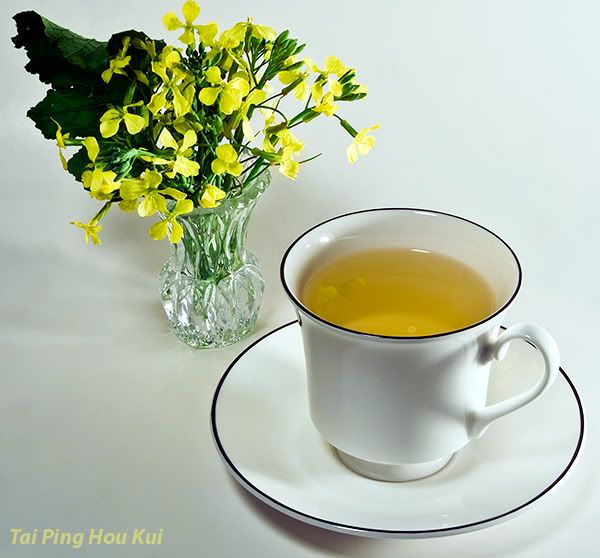Welcome TeaChatters to TeaDay. Please come in and share what is in your cup today!
Yesterday 75% of responders indicated water temp was at least very important when brewing their fave type of tea. You can still vote and discuss yesterday's topic.
Today's TeaPoll and discussion topic. Coming closer to the end of our current topic theme, but not yet. We continue discussion on brewing variables for your FAVORITE TYPE OF TEA today. Please stay focused on the importance of today's variable in brewing. TIME! How important is BREWING TIME that you use for brewing your FAVORITE TEA? Please discuss.
I am looking forward to sharing tea and TIME on TeaDay today. Bottoms up ...
May 7th, '09, 00:16
Posts: 20891
Joined: Apr 22nd, '06, 20:52
Scrolling: scrolling
Location: Back in the TeaCave atop Mt. Fuji
May 7th, '09, 02:16
Posts: 921
Joined: Feb 6th, '08, 04:57
Location: enjoying a cup of Red Rose down in GA
Time is very important, and a good way to compensate for changes in other variables. Though temperature probably ranks a bit higher...
Still going w/ an ali shan this morning. My tea drinking was curtailed yesterday afternoon b/c of time (well) spent at a restaurant w/ some old friends. So I decided to keep going w/ this pot.
Still going w/ an ali shan this morning. My tea drinking was curtailed yesterday afternoon b/c of time (well) spent at a restaurant w/ some old friends. So I decided to keep going w/ this pot.
May 7th, '09, 08:02
Posts: 511
Joined: Dec 26th, '08, 18:21
Scrolling: scrolling
Location: Atlanta, GA
Contact:
bsteele
I consider it very important. A few seconds either way keeps it from being paramount, but it is very important.
No tea yet but first up is a new FF Darjeeling.
Have a nice day everyone!
No tea yet but first up is a new FF Darjeeling.
Have a nice day everyone!
- Victoria -
http://victoriasown.blogspot.com/
http://victoriasown.blogspot.com/
For most teas, it's NOT critical.
Infusion length is paramount for just a few teas, when time is counted in seconds - UNLESS you are conducting serial extractions, Eastern-brewing style.
It's not the case if you are brewing tea Western-style for highly processed, porous tea (especially large-leaved Indian subspecies cultivars), such that fine control of elution character is difficult under Eastern-style brewing conditions. You want to maintain heat when a tea has odor and taste characteristics that fade at cooler temps. Thus, time and temperature factors are tightly connected, for both brewing and imbibing of many teas.
Chip can attest to it's importance for Japanese green teas, where it may be important to forestall the accumulation of strong (eg, can easily overwhelm delicate, flavor components) bitter compounds that co-elute with desired flavors.
Cooler infusion temps, and faster heat loss (a function of tea vessel wall heat capacity and diffusion rate) also control elution of oily components that adversely effect infusion quality.
Hagi's are porous enough to loose heat quickly, which aides in controlling infusion quality. Thin porcelain also serves this purpose (but lacks a thick absorptive surface that also plays a role in Hagiware brewing), while thicker clay will retain heat necessary to extract larger phenolic complexes that are oilier than early eluting compounds, but highly desired in certain processed teas - like higher elevation Ceylon, autumnal Darjeelings and Taiwanese oolongs.
A delicate Jasmine oolong this morning. Spring is limping along here.
It's not the case if you are brewing tea Western-style for highly processed, porous tea (especially large-leaved Indian subspecies cultivars), such that fine control of elution character is difficult under Eastern-style brewing conditions. You want to maintain heat when a tea has odor and taste characteristics that fade at cooler temps. Thus, time and temperature factors are tightly connected, for both brewing and imbibing of many teas.
Chip can attest to it's importance for Japanese green teas, where it may be important to forestall the accumulation of strong (eg, can easily overwhelm delicate, flavor components) bitter compounds that co-elute with desired flavors.
Cooler infusion temps, and faster heat loss (a function of tea vessel wall heat capacity and diffusion rate) also control elution of oily components that adversely effect infusion quality.
Hagi's are porous enough to loose heat quickly, which aides in controlling infusion quality. Thin porcelain also serves this purpose (but lacks a thick absorptive surface that also plays a role in Hagiware brewing), while thicker clay will retain heat necessary to extract larger phenolic complexes that are oilier than early eluting compounds, but highly desired in certain processed teas - like higher elevation Ceylon, autumnal Darjeelings and Taiwanese oolongs.
A delicate Jasmine oolong this morning. Spring is limping along here.
May 7th, '09, 10:39
Vendor Member
Posts: 2084
Joined: Sep 24th, '08, 18:38
Location: Boston, MA
I am having keemun now in my office with a little Japanese porcelain teapot. For this tea, time is not important to me. I leave the tea in the pot for the whole morning, but it's important to have the teapot lid removed till the water cools down.
For many other teas, time would be extremely important. My favorite inexpensive dan cong is a typical example - super fragrant when infused for seconds, but very bitter with slightly longer infusion. It's angel and demon in one!
For many other teas, time would be extremely important. My favorite inexpensive dan cong is a typical example - super fragrant when infused for seconds, but very bitter with slightly longer infusion. It's angel and demon in one!
By sitting in peace and doing nothing,
You make your one day worth two days.
You make your one day worth two days.
